Kuri Kinton (Candied Chestnuts and Sweet Potatoes) is a special dish of Osechi Ryori, or traditional Japanese New Year foods. Sweet and slightly nutty, this smooth and creamy dish symbolizes economic fortune and wealth. Let’s make this for a prosperous year ahead!
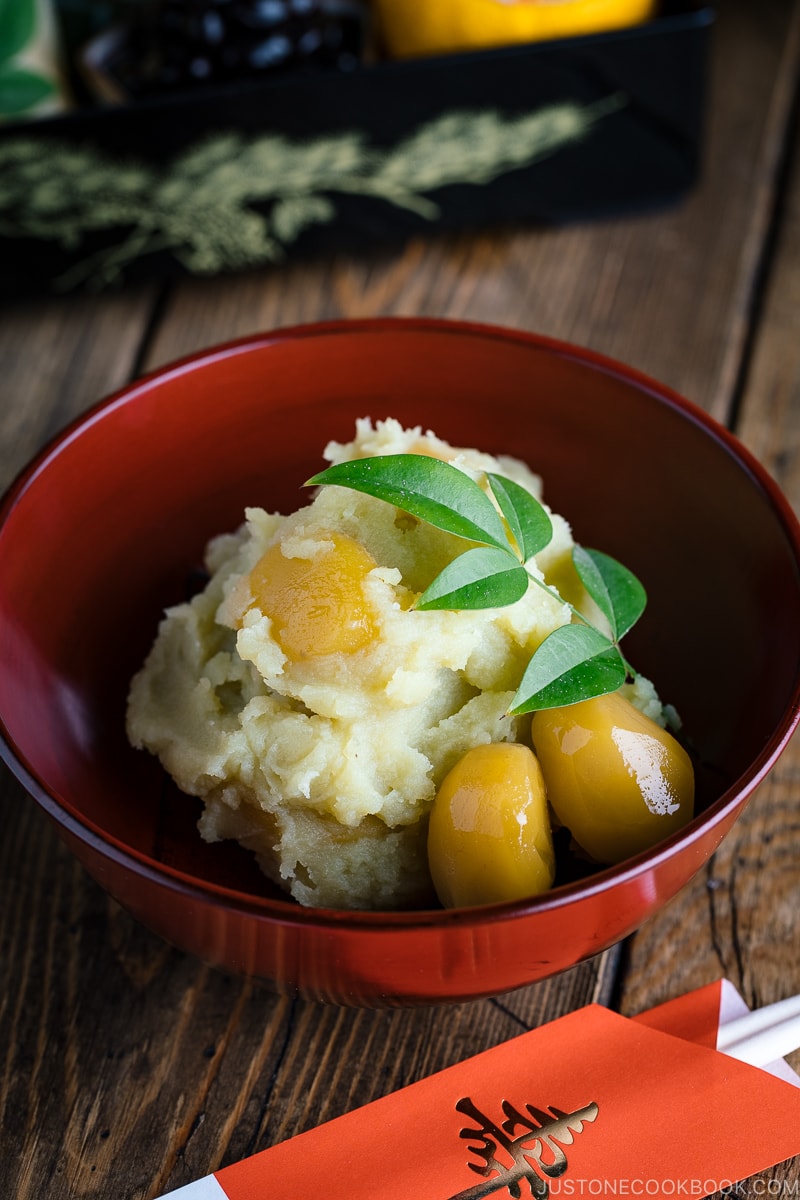
As part of my Osechi Ryori Recipe Series (traditional Japanese New Year Food), I am bringing you a popular dish called Kuri Kinton or Candied Chestnuts with Sweet Potatoes. This auspicious item is smooth, creamy, slightly nutty with a bright, golden yellow color. It certainly adds a touch of elegance to the New Year’s feast.
What is Kuri Kinton
Kurikinton (栗金団), literary “chestnut gold mash,” symbolizes economic fortune and wealth. Made of mashed sweet potatoes and chestnuts in syrup, kuri kinton is an important dish to bring good luck and prosperity for the new year.
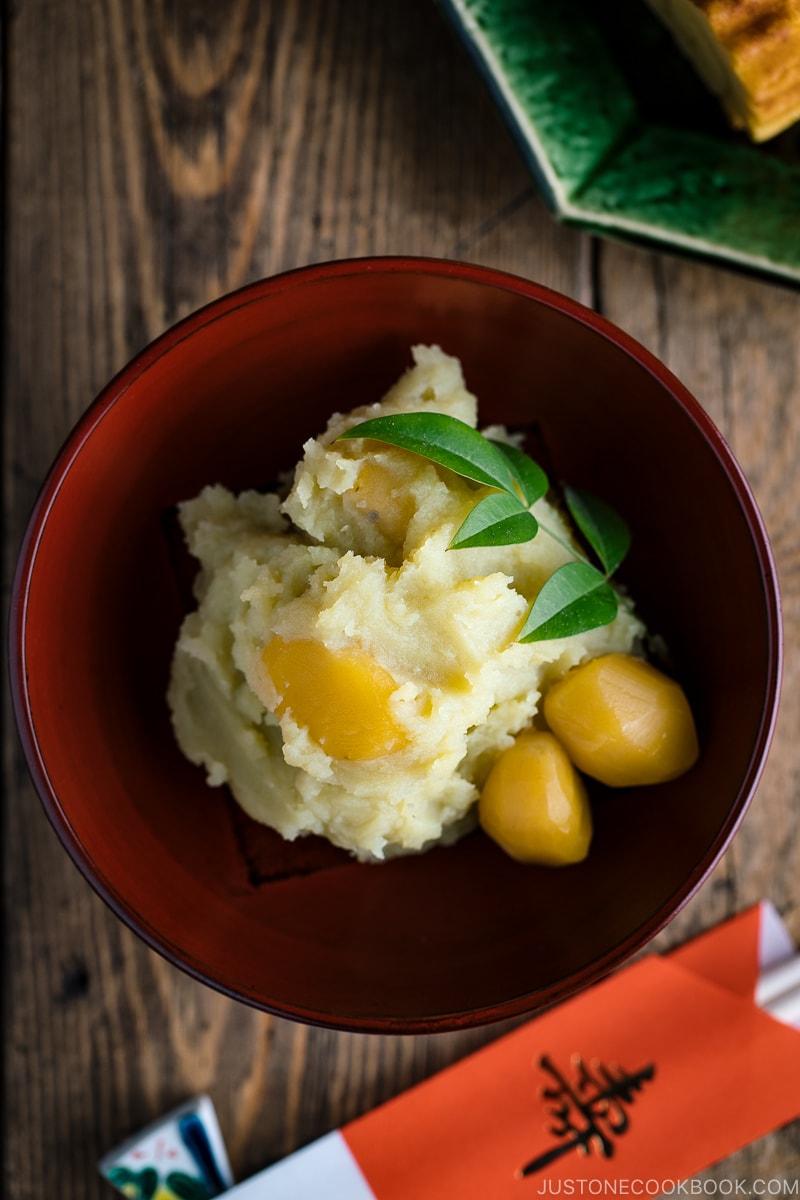
Kuri kinton is on the sweet side, but it is not considered a dessert in Japanese cuisine. You’ll find most traditional osechi ryori dishes are seasoned more heavily with vinegar and sugar so the food are preserved and store well for several days for the New Year. That said, you can always adjust the sweetness to your liking.
Traditionally we put dried gardenia pods (kuchinashi no mi, くちなしの実) while simmering the sweet potatoes. The gardenia pods give a bright yellow color and they are used to naturally color other food such as “takuan” radish pickles and noodles. Unfortunately, I could not find these pods in the US so I couldn’t add them while cooking (Update: you can now find it on Amazon). The yellow color in the photos is purely from the Japanese sweet potatoes.
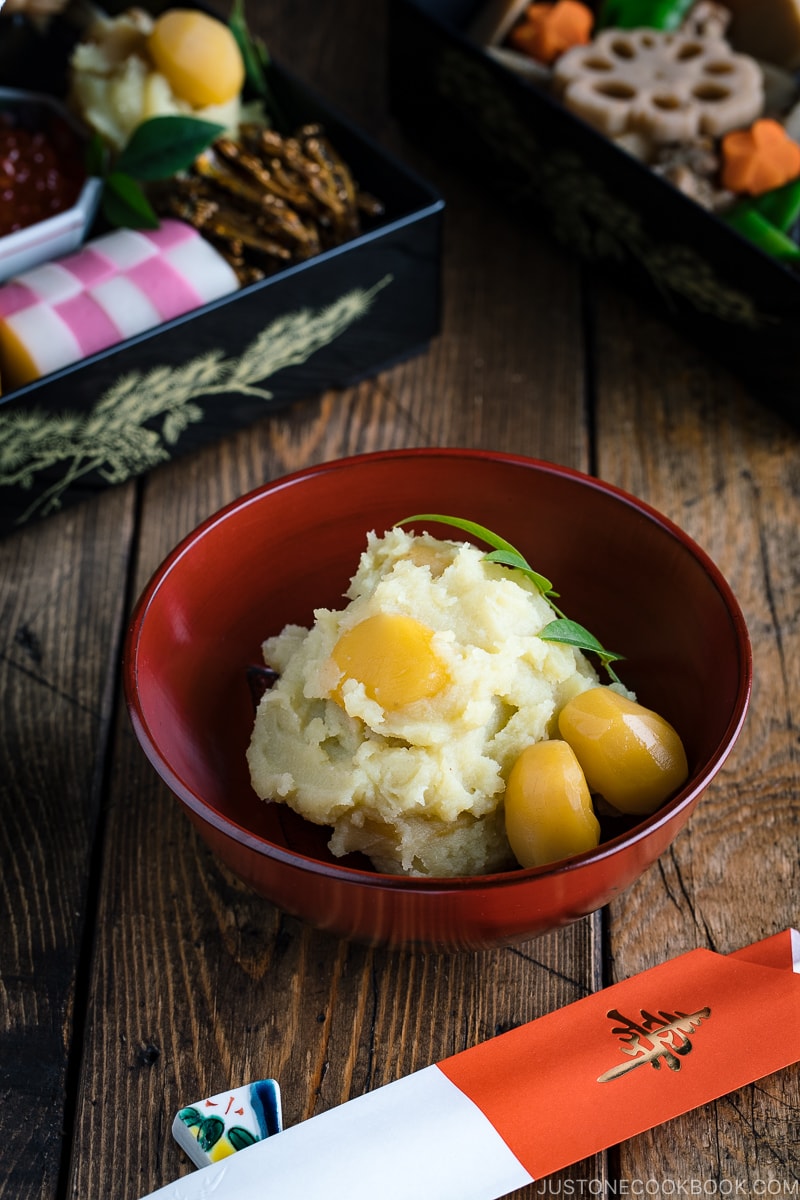
2 Important Ingredients to Make Kuri Kinton
1. Candied Chestnuts
You can make candied chestnuts from scratch by peeling the chestnuts (this alone takes hours!), cooking them till tender, and preserving them in syrup. But that’s not something most of us have the time to do. So I use this jar of chestnuts in heavy syrup called kuri kanroni (栗甘露煮) for my Kuri Kinton recipe. Kuri kanroni is commonly used in making wagashi, Japanese sweets, such as yokan or manju.
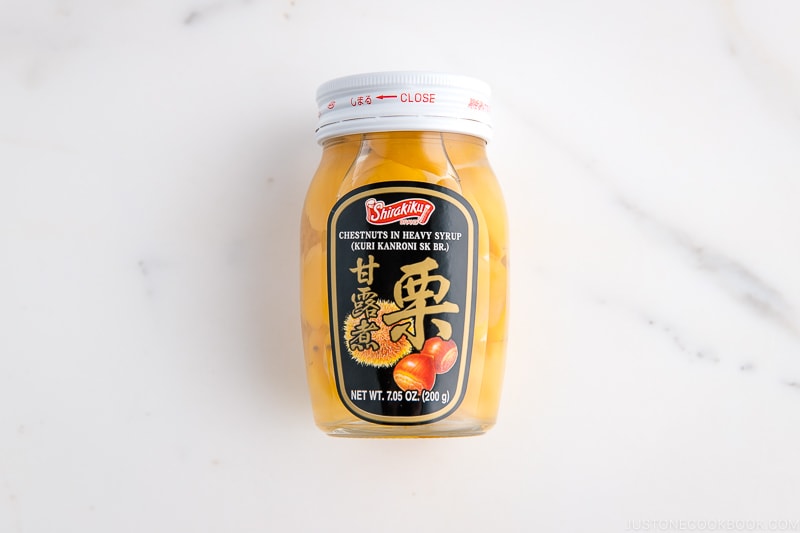
2. Japanese Sweet Potatoes
For kuri kinton, please use only Japanese sweet potatoes called satsumaimo (さつまいも), and not any other types of sweet potatoes. Japanese sweet potatoes are known for its starchy texture and intensely sweet flavor, which makes them an ideal choice for desserts such as Japanese Sweet Potato, Daigaku Imo, and Sweet Potato Pie.
You can easily find them at mainstream grocery stores or local farmers in the US these days.
Learn more about Japanese sweet potatoes on my pantry page.
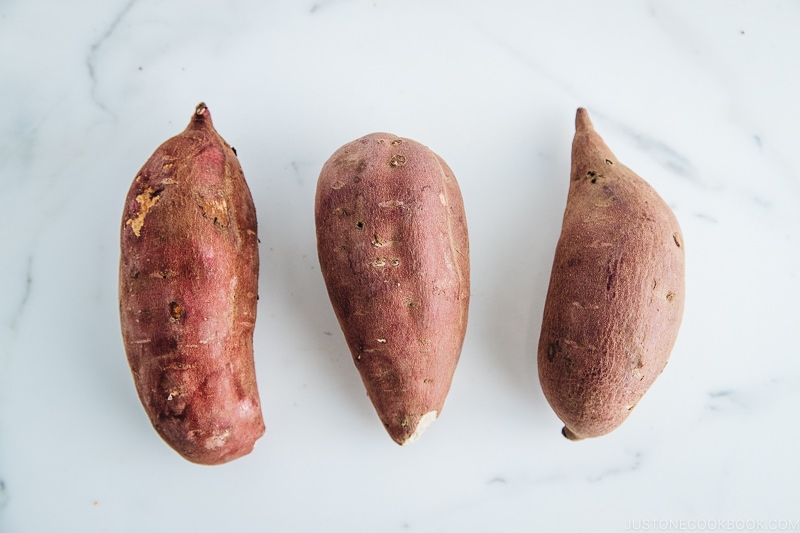
Both chestnuts and sweet potatoes are signature winter harvests and the epitome of Japanese New Year festivities. You cannot miss it when making osechi for the family!
More Osechi Ryori Dishes
- 7 Popular Side Dishes & Desserts to Serve with Osechi Ryori
- Kuromame (Sweet Black Soybeans)
- Chikuzenni (Simmered Chicken and Vegetables)
- Tataki Gobo (Pounded Burdock Root with Sesame Sauce)
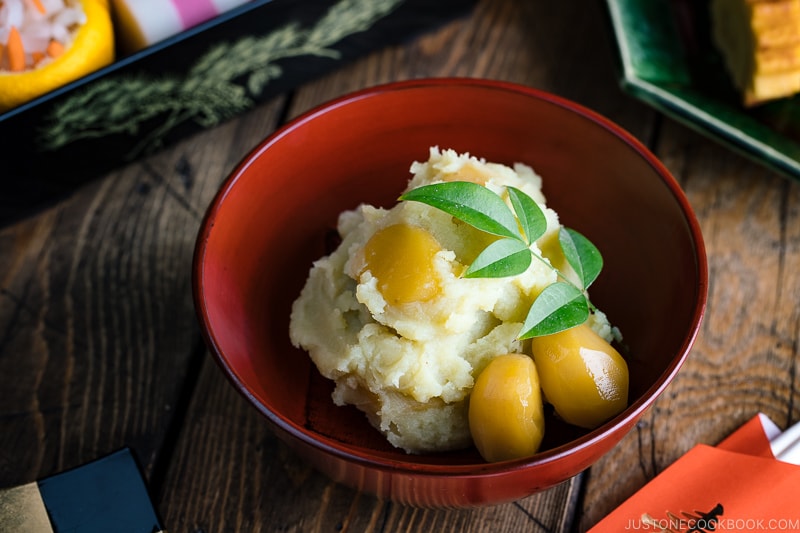
Wish to learn more about Japanese cooking? Sign up for our free newsletter to receive cooking tips & recipe updates! And stay in touch with me on Facebook, Pinterest, YouTube, and Instagram.
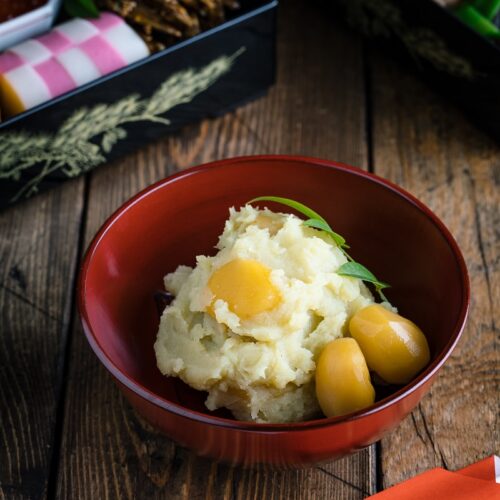
Kuri Kinton (Candied Chestnuts and Sweet Potatoes)
Ingredients
- 1.1 lb Japanese sweet potato (Satsumaimo)
- 1 jar kuri kanroni (chestnuts in heavy syrup) (7 oz, 200 g; about 10 chestnuts; also known as marrons glacés)
- ½ cup sugar
- ½ tsp Diamond Crystal kosher salt
- 3 Tbsp syrup from kuri kanroni
- 1 Tbsp mirin
For the Coloring
- 2 kuchinashi no mi (dried gardenia pods) (optional; these pods give a bright yellow tint when simmered with the sweet potatoes; if you can find them, crack the pods in half and wrap in cheesecloth)
Instructions
- Before You Start: If you will include this dish in your Osechi meal, I recommend cooking it 2 days before you plan to serve. For more helpful tips on planning your Japanese New Year feast, please read my A 5-Day Osechi Cooking Timeline blog post.
- Gather all the ingredients.

- Peel 1.1 lb Japanese sweet potato (Satsumaimo) and slice them into ½-inch (1.3-cm) pieces so that they will cook evenly.

- Soak the sweet potatoes in water for 15 minutes to remove the starch. Then, drain and put them in a large pot. Add just enough water to cover them.

- Bring the water to a boil on medium heat. Once boiling, lower the heat to medium low and cook for 15–20 minutes or until a skewer pierces the sweet potatoes smoothly. Then, reserve about ¼–½ cup of the cooking water. Drain the sweet potatoes completely.

- Using a wooden spatula, mash the boiled sweet potatoes through a fine-mesh strainer or sieve to purée them. You can also use a food processor, adding a tiny bit of the reserved cooking liquid if required.

- The finished puréed sweet potato is pictured in the image to the left. Next, remove the chestnuts and syrup for the recipe from 1 jar kuri kanroni (chestnuts in heavy syrup).

- To the same pot, add the puréed sweet potato, ½ cup sugar, ½ tsp Diamond Crystal kosher salt, 1 Tbsp mirin, and 3 Tbsp syrup from kuri kanroni. If you are using the optional 2 kuchinashi no mi (dried gardenia pods), crack them in half and wrap in cheesecloth; then, add to the pot.

- Set the pot on low heat and cook, stirring constantly, until the sugar has dissolved completely. If needed, add the reserved cooking liquid to loosen up the paste (I did not add). Adjust the sweetness with the syrup and mirin.

- Add the chestnuts to the pot and cook until heated through, about 3–5 minutes. Remove from the heat and let it cool completely.

To Serve
- Serve the Kuri Kinton at room temperature.

To Store
- Transfer the Kuri Kinton to an airtight container and store in the refrigerator for up to 3–4 days.
Nutrition
Editor’s Note: This post was originally published on December 28, 2012. The post has been updated with new images in December 2019 and republished in December 2021.
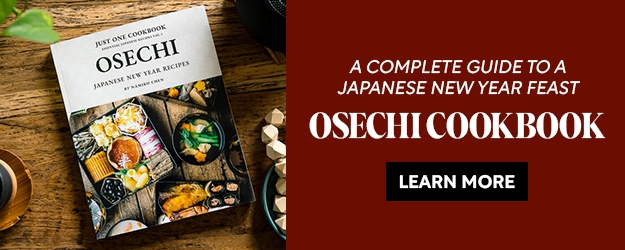
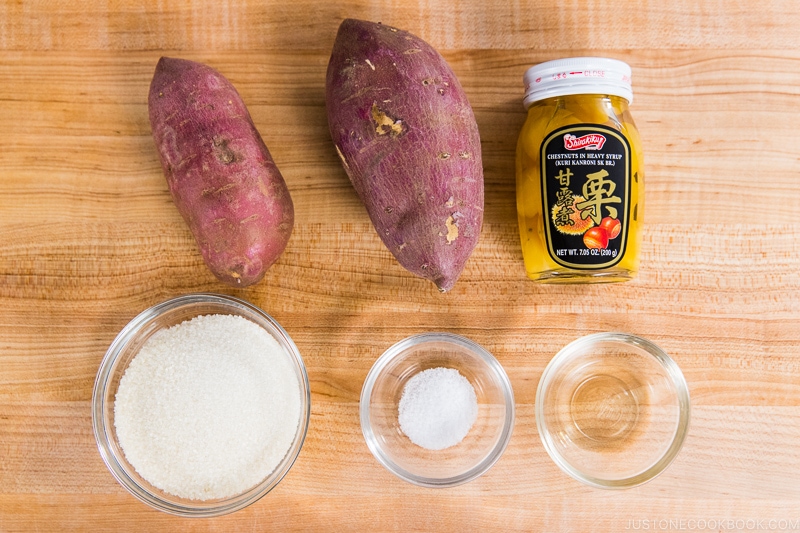
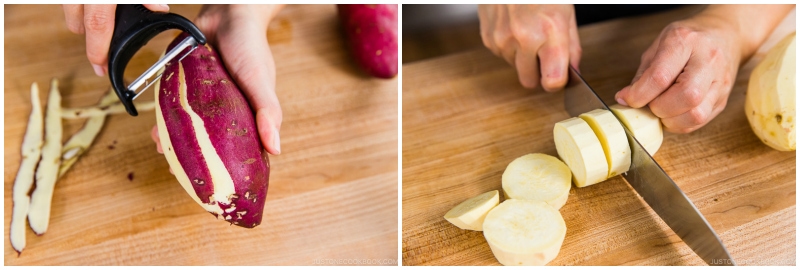
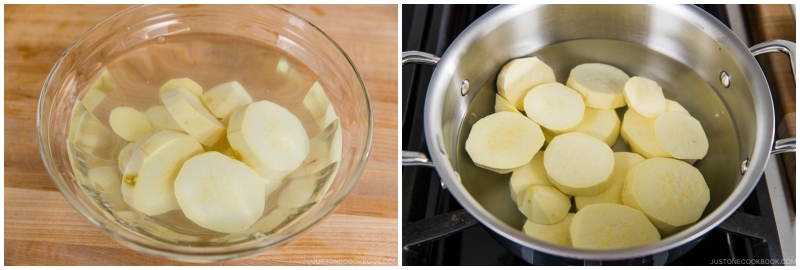
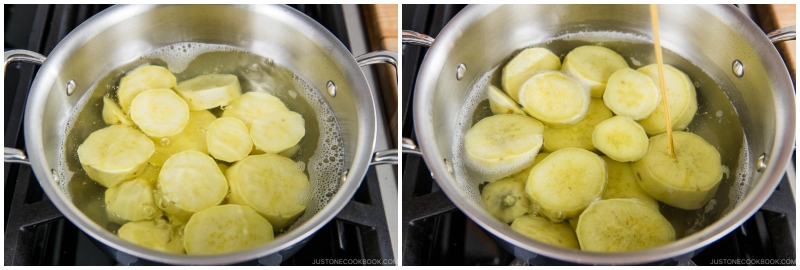

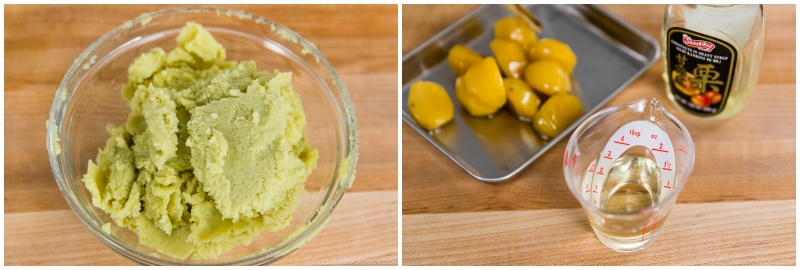
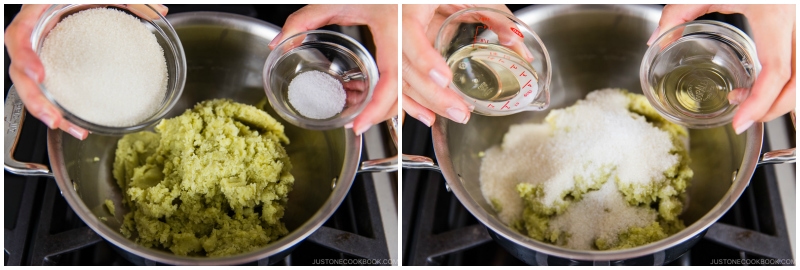
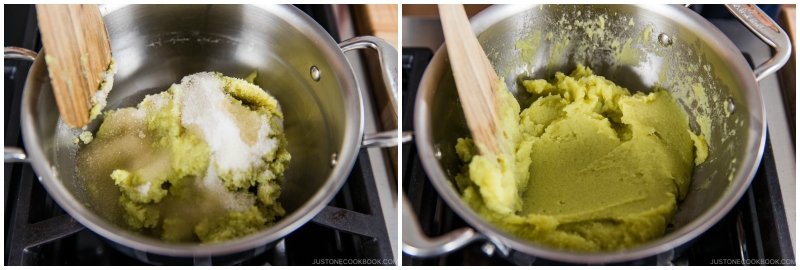
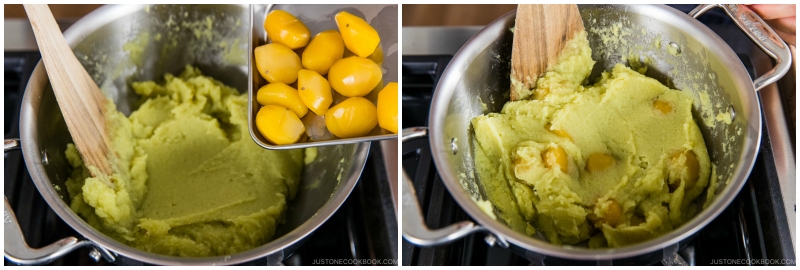
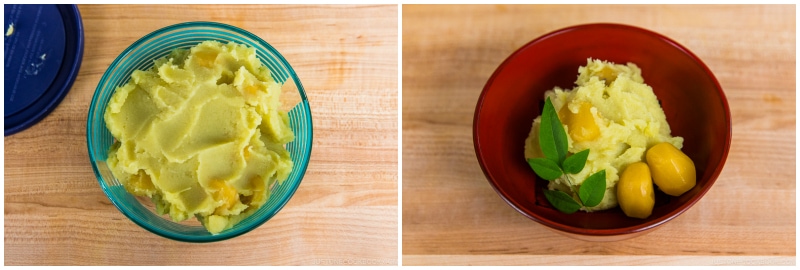










Delicious! I eliminated the extra sugar because the satsumaimo is sweet enough on its own. Especially with the added sweetness of the chestnut syrup, I thought it might end up too sweet with the added sugar. I should have kept a few chestnuts aside for decoration as in your gorgeous photo. I will do that next time 🙂
Hi Mari! Thank you so much for trying Nami’s recipe and sharing your experience with us. 🤗
I added the kuchinashi to the pot when I was first boiling the sweet potato’s. They made the potatoes a nice color and the potato water was nice and bright yellow.
Awesome, Shirley! We are glad you found Kuchinashi!
Thank you so much for trying Nami’s recipe!
Hi Naomi,
Thank you for this recipe and all the other wonderful recipes. I’ve been making this kuri kinton recipe for the last 3 new years. I typically make it 2 – 3 days before Jan 1. Each time the dish turns a little green by New Year’s Day. Is there any way to prevent it from taking on a green hue? It still tastes great.
Hi Julie! Thank you so much for your kind words about Nami’s recipes.
Nami and all of us at JOC are so happy to hear you enjoy them.😊
As Nami mentioned in this post, we recommend using gardenia berries for color, but you can also try squeezed lemon juice to prevent color change.
We hope this helps!
I just want to share this little tip for anyone in the US who has an Asian market nearby but no kuri kanroni jars. This year, my local store didn’t have them, but they did have a Korean product, “Chestnuts in syrup” from Assi brand. They’re in a plastic vacuum pouch in the refrigerator section. I am using them this year and they worked well for me. So if you have trouble finding the Japanese ones, look for these, especially if you’ve got a well-stocked Korean grocer nearby. There was JUST enough syrup for the recipe (3 tbsp) inside the pouch if you cut one corner and drain it into a cup before opening the pouch. However, there are about twice as many chestnuts as you need for the recipe in the bag I found, so I used only half. Also, they seemed maybe firmer than the jar ones, so you may need to cook them more. I am letting the finished dish rest with a lid on for about 15 minutes after heating them to help them soften, then leaving the lid cracked open while they continue to cool (so they’ll retain heat for a while but not get soggy from condensation.
Also, the Assi brand apparently has a canned version in a heavier syrup closer to the one used in this recipe. Saw it online but not in the store. Hope that helps some people. If you can’t find Japanese, there may be the Korean one!
Hi Lion! Thank you very much for sharing the information with us! 😊
I found the canned Assi; can confirm the end result is absolutely delicious.
I made Kuri Kinton for the first time this year. Good recipe. Since I made it for more than 6 servings, I doubled the recipe. I recommend having an extra jar of the chestnuts because I now have very few chestnuts left and lots of the potato. My only change was to not use the sieve or a food processor but to use my hand-held blender to break up all the fibrous bits. It worked beautifully.
We think it would make an excellent filling for a cake too.
Hi Yoko,
Thank you very much for trying this recipe and for sharing your cooking experience and tips with us!
We are glad to hear you enjoyed it.
Best place to purchase Kuri Kanroni
Hi Kyoshi,
We are glad to hear you like Kuri Kanroni.
https://www.justonecookbook.com/kuri-kanroni-chestnuts-in-heavy-syrup/#
We purchase this from local Asian or Japanese grocery stores.🙂